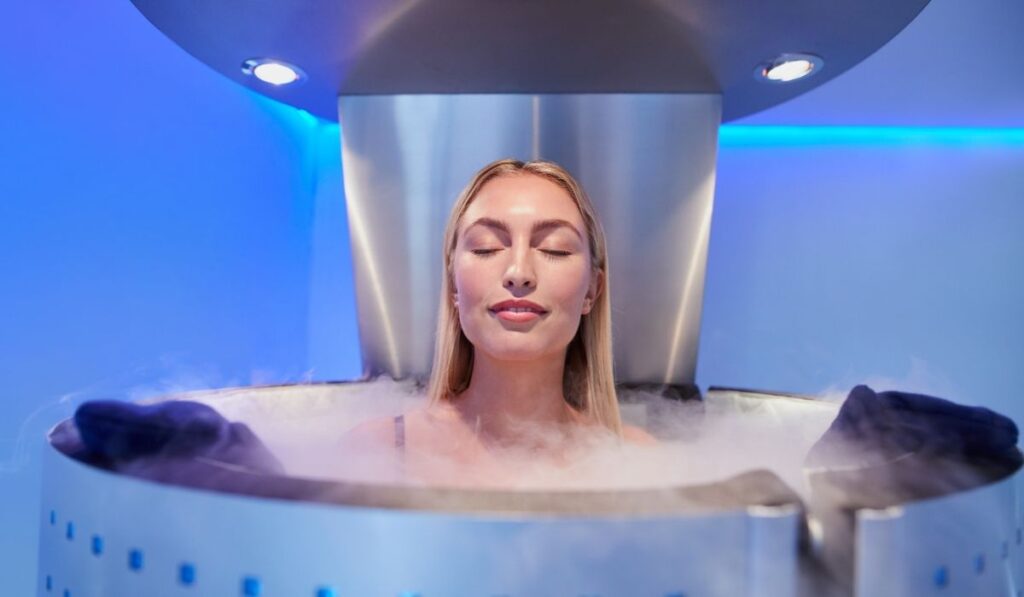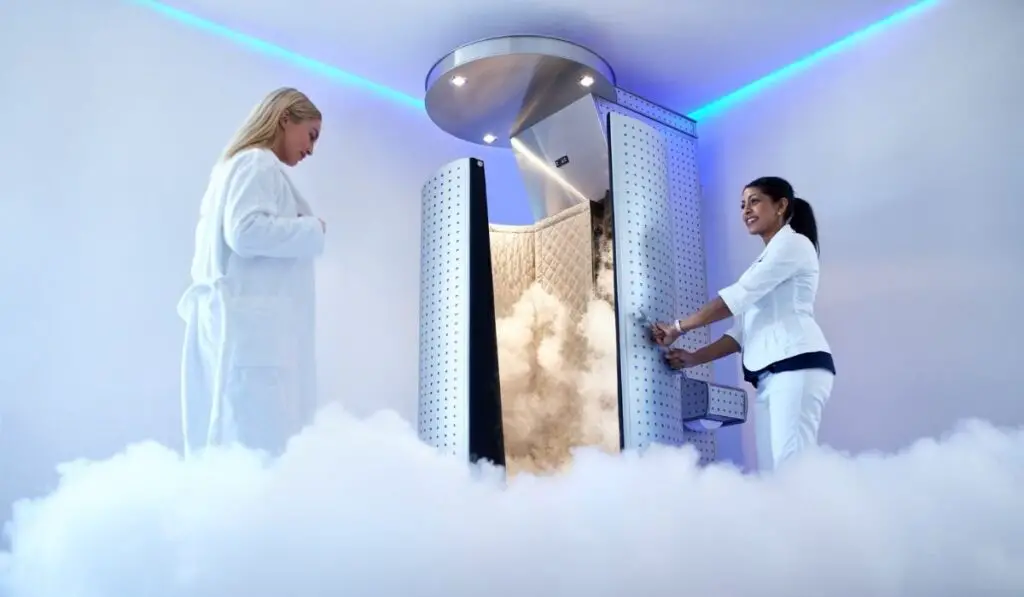Cryotherapy and sauna use are two opposite sides of the temperature therapy spectrum. While both can play their own roles in your health, can you use them together? This is a fairly common question that gets asked quite a bit. So, what happens when you grow from a sauna to a cryotherapy session?
Industry professionals agree you should wait until your body returns to a normal temperature before starting a sauna session after a cryotherapy session. While high heat and deep cold are beneficial extremes, slingshotting from one to the other can overstress your body.
Doing this will ensure your body has enough time to acclimate to the new conditions. But, are there any health benefits to doing it in this order? What about if you go from hot to cold? While there may not be a lot of research surrounding this topic, we can learn based on our body’s reaction what to expect. Ready to learn more, read on!
What Are The Effects of Cryotherapy On the Body?

When it comes to cold therapy, most often people jump to cryotherapy. This is the therapeutic process of cooling down the body to gain benefits from the exposure. It is not to be mistaken for the type of cryotherapy that doctors use to burn off skin lesions. This type of cryotherapy uses cold, usually in the form of liquid nitrogen, to freeze a part of your skin off.
The cryotherapy we are talking about is purely therapeutic in nature. It comes in the form of ice baths or, in more modern cryotherapy sessions, a hyper-chilled room. Doctors are already aware of the benefits of cryotherapy for skin lesions removal. The therapeutic version, however, is not as well-researched.
While not much hard evidence surrounds the use of therapeutic cryotherapy, many proponents laud certain health benefits, many of which we’ve explored in a separate guide. This includes a physiological effect on sore muscles, a reduction of stress and even the promotion of testosterone production.
Elements of truth are behind some of these claims. Others are a bit more dubious in nature. We currently don’t have the information we need to make definitive claims. What we do know is how cold affects the body.
Much in the way a sauna will heat the body and provide benefits, the cooling of the body can have some distinct benefits, though these are on average more anecdotal than the data we have from sauna use. We’ve all heard of icing sore muscles, and cryotherapy has seemed to show reduce muscle fatigue. However, this effect of cold on inflammation is highly debated in both the sports and medical communities.
Some people make claims that exposure to cryotherapy can help increase cardiovascular health. The idea is that when you cool your body, the blood will stop flowing to your limbs in an attempt to keep the vital organs warm. There is still some doubt about how this affects your heart, but there’s a growing that cryotherapy is in general good for you, regardless of the specific mechanism.
Mental Effects of Cryotherapy
One of the most interesting parts of the human body is our brain. Often, we can imagine physical benefits from purely mental changes. Cryotherapy is one such event that often makes people feel better about their situation. Take sore muscles, for example.
Pain is relative. What hurts you may not hurt someone else. All that variety happens in how our brains perceive pain. If you’ve torn up your shoulder on an especially hard day at the gym, cryotherapy might make your brain think that relief is in sight. After your cryo session, you might feel as if the cold therapy has had an effect.
Whether or not it actually did isn’t really the point. As long as it feels as if it did, in a way, it’s true. This is also known as the placebo effect. Partly, this is why coming to a conclusion on whether or not cryotherapy helps with conditions like inflammation is difficult. The human variable is just too chaotic.
Can You Use a Sauna After Cryotherapy?
If cryotherapy is all about the cold, then sauna use is all about the heat. Often, the two might seem like opposite sides of the spectrum. Other people might look at them and see a unified pair. In fact, pairing cold after a steamy sauna session can have some benefits. But what about the opposite?
You can definitely use a sauna after a cryotherapy session. The main concern you’d face will be dehydration, which is an issue with any sauna session. And a good tactic here is also to just consider if you have any other health concerns. If you’re “on the edge” or otherwise not feeling well because of another health condition, then you should definitely not do these treatments back to back.
Honestly, there hasn’t been much information on this particular situation published because it just doesn’t happen as often as you’d think. In most cases, you should be totally fine. Although, as medical professionals have suggested, it might be a good idea to let your body fall back to baseline before you decide to enter your sauna.
This will ensure your body is ready for the extreme temperature change. If you don’t, it’s possible that you will shock your system. Like we touched on earlier, this could exacerbate certain conditions and have a negative effect on certain people. With spas that offer the two as a therapy option, they usually recommend taking a few hours between the two. This will give your body plenty of time to recover.
Should You Use the Sauna Before Cryotherapy

Ok, so we’ve already explored what happens when you go from cryotherapy to a steamy sauna session. While it can be beneficial, there really isn’t much evidence to support that it can add anything to your health. But what about if we switch the order. What if you decide you want to undergo a cryotherapy session after you sweat it out in a sauna?
This is a pretty common question. In fact, we’ve been asking this question as long as we’ve been enjoying saunas. Even when you look at culturally traditional use, you often see an ice plunge as the following activity. Some might even argue it’s a required part of a steamy soak.
If you take a look at traditional saunas in places like Finland or Sweden, you see that taking an icy plunge in a frozen lake is common practice. But why? Well, other than the immediate, if not overdone, sense of relief from the heat feels good. Also, it can help constrict the pores on your skin.
This is great since the heat helps open your pores up and clean them out. It also constricts your blood vessels and affects blood pressure. This can be good for building cardiovascular health, although, if you suffer from poor heart health or high blood pressure, you may want to avoid an icy plunge.
What Else Should You Do (Or Avoid) After Cryotherapy?
After you undergo a cryotherapy session, there are a few things you might want to do. Again, it’s worth separating therapeutic cryotherapy from medical cryotherapy as the two are quite different. If you are going through medical cryotherapy, you’ll want to follow your doctor’s instructions.
This type of cryotherapy utilizes liquid nitrogen and can cause blistering and other skin problems. Proper care comes in the form of adding moisture to the skin and keeping everything clean. Therapeutic cryotherapy is much different.
For one, extreme temperatures are rarely ever used, at least not enough to cause any damage to your skin. Next, aftercare is pretty simple. First, you’ll want to keep yourself hydrated. While you don’t lose any sweat, your skin will benefit from the extra water in your system.
Next, you probably want to wait a few hours before exercising or anything else that can bring up your body temp. We’ve explored in another article how using a sauna pre or post-workout is a meaningful decision, and there’s some overlap with that logic around cryotherapy as well. Be sure to factor in your overall body stress when considering the order of these things.
Wrapping Up
While you shouldn’t see too many issues going from cryotherapy to sauna use, exercise caution. At the very least, give yourself a few hours to make sure your body has fully recovered from the cold therapy session. This will ensure your body doesn’t feel any extra stress due to the extreme temperature change.
Going from hot to cold, though, can have some benefits. Namely, it has an effect on blood pressure. For most of us, this can be a good thing. For individuals with heart issues, always consult the appropriate professionals to make sure everything is good to go.


